Social Welfare
International Day Against Drug Abuse and Illicit Trafficking 2025
Towards a Safer, Drug-Free Future
Posted On: 25 JUN 2025 5:01PM
|
Key Takeaways
- On 7th December 1987, the United Nations General Assembly (UNGA) decided to observe 26th June as the International Day against Drug Abuse and Illicit Trafficking.
- In 2024, all law enforcement agencies seized narcotics worth approximately ₹25,330 crore.
- In the year 2014, 1,17,284 kg of narcotics destroyed by agencies under Ministry of Home Affairs.
- The agencies also seized narcotics totaling 4,134 kg in the year 2024 from the deep seas.
|
Drug Seizures & Arrests by NCB (2004–2024)
|
|
Categories
|
2004–2014
|
2014-2024
|
|
Cases Registered
|
1,250
|
4,150
|
|
Arrests Made
|
1,360
|
6,300
|
|
Drugs Seized (kg)
|
1.52 lakh kg
|
5.43 lakh kg
|
|
Value of Drugs Seized
|
₹5,900 crore
|
₹22,000 crore
|
|
Introduction
Drug abuse continues to be a global challenge, silently harming individuals, breaking families and weakening communities. Its impact goes beyond addiction; it causes lasting physical, mental and social damage. Recognising the growing concern, the United Nations General Assembly took a decisive step on 7 December 1987. It designated 26 June as the International Day Against Drug Abuse and Illicit Trafficking.
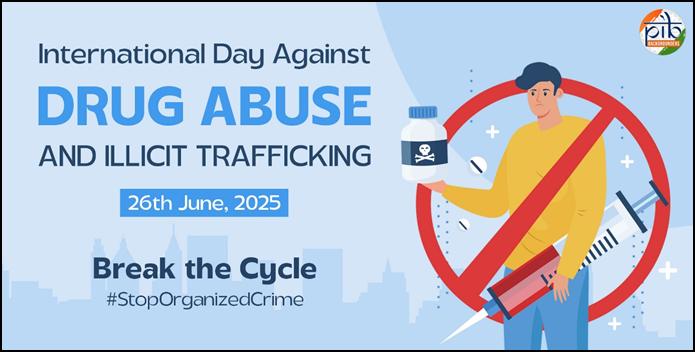
Since then, 26 June has served as a global reminder to raise awareness, promote preventive measures and strengthen cooperation among nations to curb drug abuse and trafficking. This year, the focus is on breaking the cycle of organised crime and drug trafficking.
A Zero-tolerance policy towards drug abuse
The government has adopted a zero-tolerance policy towards drugs with a focused and organised approach. The Government of India has emphasised the need to turn this fight into a Jan Andolan by spreading awareness among the youth and the public to achieve the vision of a drug-free India. In a span of just one year, this approach has led to a significant rise in drug seizures, arrests, and coordinated crackdowns across the country.
In 2024, law enforcement agencies across India, including the NCB seized drugs worth around ₹25,330 crore; over 55% more than the ₹16,100 crore seized in 2023. In 2024, the seizure of more harmful and addictive synthetic drugs, cocaine and pharmaceutical drugs used as psychotropic substances has increased significantly.
ATS (Amphetamine-Type Stimulants) are synthetic drugs that harm the brain, heart and nervous system.
- Methamphetamine (Meth): A crystal-like drug that severely damages the brain and heart.
- Cocaine: A white powder that can cause heart attacks and strong addiction.
- Mephedrone: A party drug that leads to anxiety, confusion and heart issues.
- Hashish: Made from cannabis, it affects memory and mental health.
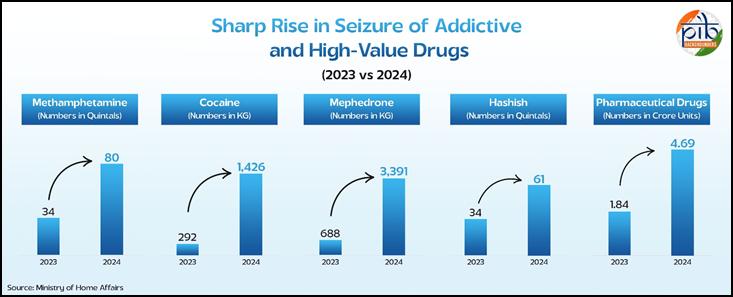
NCB’s Decade of Action
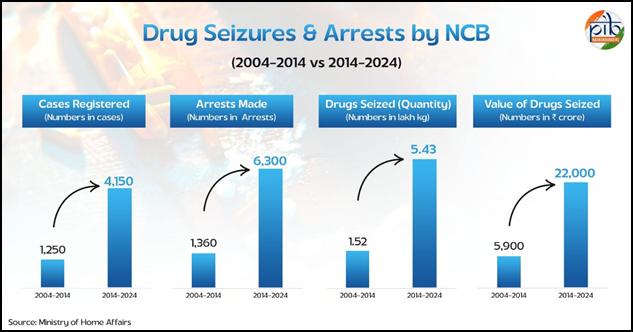
Narcotics Control Bureau (NCB), over the years, has been working tirelessly to break the network of drug trafficking and abuse through a coordinated national strategy. The past decade has seen a sharp increase in cases registered, arrests made, and the quantity and value of drugs seized.
The Narcotics Control Bureau (NCB) was established on 17th March 1986 by the Government of India to lead the national effort against drug trafficking and abuse. Operating under the supervision of the Central Government, NCB coordinates enforcement actions across states and various agencies under the NDPS Act and related laws. It also ensures India’s compliance with international conventions, supports global cooperation to combat drug trafficking, and works with other ministries to address issues related to drug abuse.
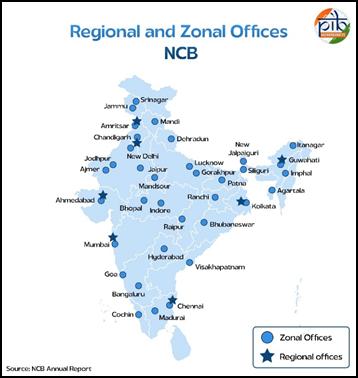
To boost nationwide drug enforcement, the Narcotics Control Bureau has been significantly strengthened through major structural expansion.
NCB-specific Expansion
- Regional Offices: Increased from 3 to 7 (e.g., Amritsar, Guwahati, Chennai, Ahmedabad)
- Zonal Offices: Expanded from 13 to 30, including new ones at Gorakhpur, Siliguri, Agartala, Itanagar, and Raipur.
- Staff Strength: Added 536 posts raising sanctioned strength to 1,496.
- Narco-Canine Pool: Nar-K9 units deployed in 10 zonal offices for enhanced detection.
Breaking the Narco-Terror Nexus
In a major step towards eliminating the drug menace, agencies in 2024 achieved the country’s biggest offshore drug seizure. Under the leadership of the Ministry of Home Affairs, a whole-of-the-government approach is being adopted to dismantle drug networks and bring perpetrators to justice.
- In a joint operation carried out by the NCB, the Navy and the Gujarat Police, a gigantic consignment of 3132 kg of drugs was seized.
- Security agencies busted an international drug trafficking cartel and seized over 700 kg of contraband methamphetamine in Gujarat.
- NCB confiscated 82.53 kg of high-grade cocaine in New Delhi.
- The massive drug consignment worth approximately Rs 900 crore was tracked down by a bottom-to-top approach after a quantity of drugs were seized in a courier center in Delhi.
- The agencies also seized narcotics totaling 4,134 kg in the year 2024 from the deep seas.
- In the year 2024, the agencies under MHA destroyed 1,17,284 kg of narcotics.
Measures to Curb Drug Trafficking
The Union government has tried to fight this battle in the last 5 years based on the ‘whole of government approach’ and on the three pillars of structural, institutional and informational reforms.
- 4‑Tier NCORD (Narco-Coordination Centre) Mechanism: Coordination from Apex to District level across all stakeholders via a unified portal.
- Anti-Narcotics Task Force (ANTF): Dedicated teams led by senior police officers in each State/UT to implement NCORD decisions.
- Joint Coordination Committee (JCC): Chaired by the NCB DG to monitor major drug seizures and investigations.
- Empowered Border & Railway Forces: BSF (Border Security Force), Assam Rifles, SSB (Sashastra Seema Bal), Indian Coast Guard and RPF (Railway Protection Force) are authorized under the NDPS Act to carry out search, seizure and arrests in cases related to drug trafficking.
The NDPS Act (1985) is India’s main law to prevent and control drug abuse and illegal drug trafficking. It bans the production, sale, and use of narcotic drugs and psychotropic substances unless allowed for medical or scientific purposes. It provides strict punishments for violations and supports treatment for drug dependents.
- Inter-Agency Joint Operations: NCB coordinates with Navy, Coast Guard, BSF, State ANTF and others for nationwide operations.
- Capacity Building & Training: Ongoing professional training provided to all drug enforcement agencies.
- Darknet & Crypto Task Force: MAC‑level unit focused on cyber drugs trafficking trends, monitoring, and legal updates.
MAC stands for Multi-Agency Centre. At the MAC level, different intelligence and enforcement agencies in India come together to share information, coordinate actions and monitor threats, including those related to drug trafficking, terrorism and organized crime.
- National Helpline (MANAS 1933): 24×7 toll-free platform for drug-related queries and reporting.
- Forensic Lab Support: Central assistance for upgrading State forensic facilities.
- Maritime Security Group – NSCS (National Security Council Secretariat): Established in November 2022 to analyze and address sea-route drug trafficking.
- International Cooperation: DG-level bilateral dialogues with neighbours (Myanmar, Iran, Bangladesh, etc.) focused on maritime and land drug routes.
Fighting Drug Abuse
To address the growing challenge of substance use, the Ministry of Social Justice & Empowerment developed and implemented targeted programmes focused on prevention, treatment and rehabilitation across the country.
Nasha Mukt Bharat Abhiyaan (NMBA)
Launched on 15 August 2020 by the Ministry of Social Justice and Empowerment, Nasha Mukt Bharat Abhiyaan (NMBA) is a nationwide campaign addressing substance abuse through prevention, treatment and rehabilitation.
- NMBA Website: Offers comprehensive resources, real-time dashboards, e-pledge options, and expert-led discussion forums
- NMBA Mobile App: Collects and monitors ground-level data, with wide usage by Master Volunteers.
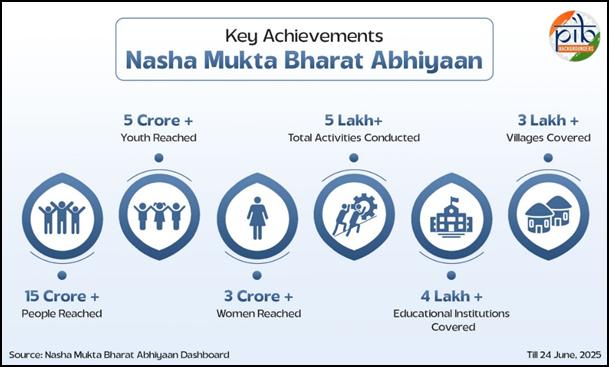
- National Toll-free Helpline (14446): Provides primary counselling and immediate referral services.
National Action Plan for Drug Demand Reduction (NAPDDR)
The National Action Plan for Drug Demand Reduction (NAPDDR), implemented by the Ministry of Social Justice & Empowerment, is a centrally sponsored scheme under which financial assistance is provided to:
- 342 Integrated Rehabilitation Centres for Addicts (IRCAs) that provide in-patient treatment to drug users along with counselling, detoxification/de-addiction, after care and re-integration into the social mainstream.
- 47 Community based Peer led Intervention (CPLI) programmes work with children below 18 to create awareness against drugs and teach life skills.
- 74 Outreach and Drop In Centres (ODICs) which provide safe and secure space with provision of screening, assessment and counselling and thereafter provide referral and linkage to treatment and rehabilitation services.
- 83 Addiction Treatment Facilities (ATFs) in Government hospitals.
- 53 District De-Addiction Centres (DDACs) which provides all three facilities provided by IRCA, ODIC & CPLI under one roof.
Success Stories
There are countless stories like that of Ramesh (name changed) that show recovery from substance use is possible with care, resilience and support. Once living a peaceful life with his family, Ramesh’s world collapsed after an accident left him jobless and emotionally shattered. Struggling with his mental health, he turned to substance use. His savings ran out, and his life spiralled. With his wife and daughter by his side, he sought help at a de-addiction centre. Though he relapsed, his family stood by him through each attempt. After three rounds of treatment, Ramesh rebuilt his life and now works as an electric technician, living a sober and hopeful life.
Sooraj (name changed), a young resident of Central Mumbai, battled substance dependency that began in college and soon disrupted his health. Concerned about his condition, his family brought him to the Kripa Foundation Integrated Rehabilitation Centre. There, health professionals assessed his condition and supported his detox with clinical care and counselling. Through continued psychosocial support, Sooraj embraced sobriety and a healthier way of living. Today, he leads a clean and stable life; an example of how timely intervention and the will to change can transform one’s future.
Conclusion
The International Day Against Drug Abuse and Illicit Trafficking serves as a global reminder of the urgent need to combat the drug menace through coordinated action, awareness, and rehabilitation. With a zero-tolerance policy, robust enforcement efforts, and people-centric initiatives like Nasha Mukt Bharat Abhiyaan, India continues to take firm steps towards building a safer, healthier, and drug-free future.
References
PIB Backgrounders:
United Nations Office on Drugs and Crime:
Ministry of Home Affairs
Ministry of Social Justice and Empowerment
Social Media Links:
International Day Against Drug Abuse and Illicit Trafficking 2025
***
Santosh Kumar/ Ritu Kataria/ Kamna Lakaria
(Backgrounder ID: 154754)
Visitor Counter : 348
Read this release in:
Hindi